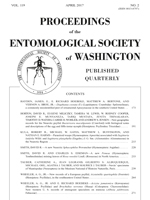The Nearctic psyllid Bactericera maculipennis (Crawford) (Hemiptera: Psylloidea: Triozidae) is one of only five known species of Psylloidea worldwide whose host plants include species of Convolvulaceae (Solanales). Current checklists of North American Psylloidea report B. maculipennis only from California and Utah. Our surveys of field bindweed, Convolvulus arvensis L. (Convolvulaceae), an Old World plant introduced into North America, show that B. maculipennis is considerably more widespread than indicated by historical accounts. We update the psyllid's geographic range to include four states (Washington, Idaho, Oregon, Montana) not previously included in contemporary checklists. The egg and fifth instar nymph are described. We provide characters of the egg and nymph that distinguish this species from a congeneric species, Bactericera cockerelli (Šulc), occasionally found on field bindweed. Photographs of the male and female terminalia are provided. Bactericera maculipennis developed successfully on field bindweed and on several species of Ipomoea (Convolvulaceae) in laboratory assays. Overwintering females collected from leaf litter and dead or dormant stems of C. arvensis at locations in Central Washington mated and began to oviposit within 7 days of removal from the field, suggesting that B. maculipennis overwinters in a temperature-controlled quiescence rather than in a true reproductive diapause. Eggs and nymphs of B. maculipennis were found on stems of C. arvensis well into November in Central Washington, suggesting that this psyllid also may overwinter in pre-adult stages, as indicated by literature accounts from the 1940s and 1950s. Lastly, we propose that successful colonization of the invasive and exotic weed C. arvensis by B. maculipennis has allowed the psyllid to expand its geographic range well beyond historical boundaries. This conclusion is based upon the scarcity of native Convolvulaceae within regions in which the psyllid is newly recorded, combined with the now extensive distribution of the invasive C. arvensis in North America.
How to translate text using browser tools
23 May 2017
New Geographic Records for the Nearctic Psyllid Bactericera maculipennis (Crawford) with Biological Notes and Descriptions of the Egg and Fifth-Instar Nymph (Hemiptera: Psylloidea: Triozidae)
David R. Horton,
Eugene Miliczky,
Tamera M. Lewis,
W. Rodney Cooper,
Joseph E. Munyaneza,
Tariq Mustafa,
Jenita Thinakaran,
Timothy D. Waters,
Carrie H. Wohleb,
Andrew S. Jensen
ACCESS THE FULL ARTICLE
Bactericera cockerelli
Convolvulaceae
Convolvulus
field bindweed
geographic spread
Ipomoea
jumping plant-lice





